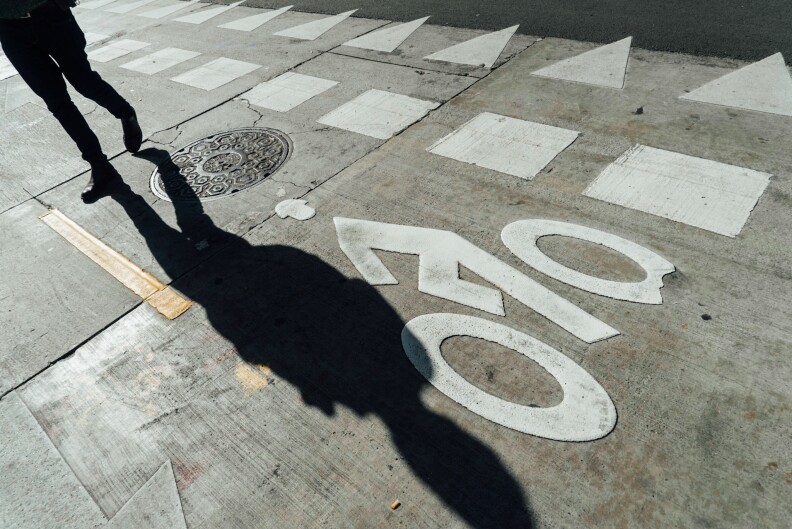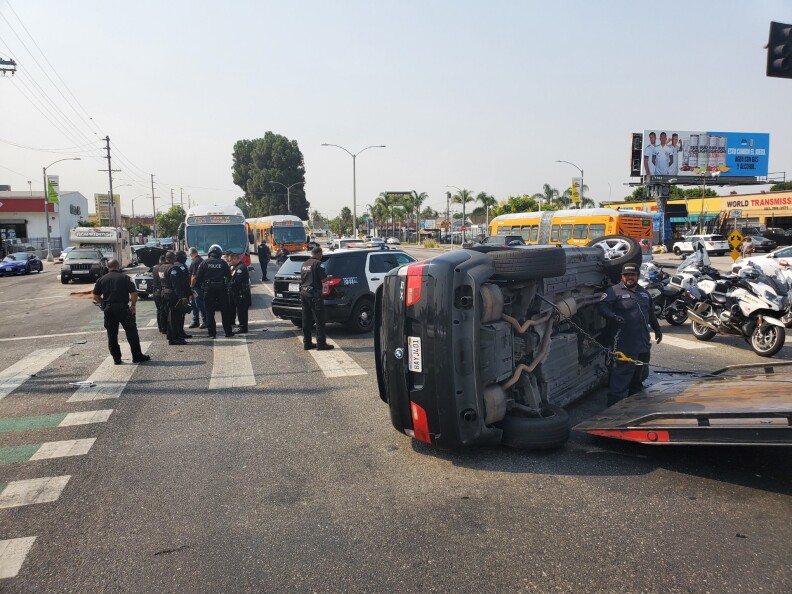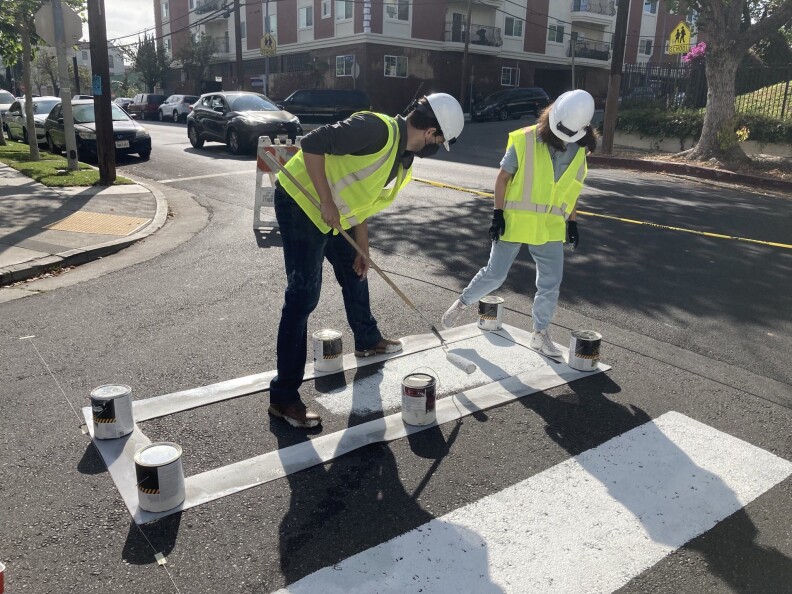‘A Threat To Public Safety’: LA’s Street Improvement Programs Are Severely Understaffed

The city department charged with making Los Angeles streets safer has suffered from significant understaffing as it falls far behind on its work to save lives, according to information provided by city transportation officials.
City Councilmember Paul Krekorian calls the current vacancy rate at L.A.’s Department of Transportation “a threat to public safety.”
At the same time, the death toll on L.A. streets continues to rise. Within the first 15 weeks of 2022, 95 people were killed in crashes, according to preliminary city data. In the same period last year, the toll was 87.
The number of pedestrians killed by drivers is especially grim — up 53% citywide compared with the same period last year. The greatest share of those victims is in South L.A., where pedestrian deaths more than doubled from this time last year.
-
At magnitude 7.2, buildings collapsed
-
Now spinning in front of Santa Monica apartments
-
Advocates seek end to new LAUSD location policy
And last year was bad; 2021 marked the highest annual death toll in nearly two decades, with nearly 300 people killed in collisions. Roughly half of those victims were killed by drivers while walking or biking. Nearly 1,500 other people were seriously injured in crashes.
All these deaths and injuries are happening despite the city promising in 2015 to eliminate traffic deaths on local streets by 2025 — a safety initiative known as Vision Zero.
Reaching that goal will require improving safety across L.A.’s roughly 8,500 miles of streets — especially for pedestrians and cyclists. That job falls mainly to the city’s Department of Transportation, with assistance from several other departments.
LADOT also manages an "active transportation" program — designed to build a network of streets where people will choose to walk or bike rather than drive. While technically separate from Vision Zero, there is some connective tissue; making streets safer for people walking and rolling is a key factor to incentivize them to not drive.
How Bad Is The Staffing Problem?
Department-wide, 21% of positions are unfilled.
But looking specifically at the active transportation and Vision Zero programs, 50% of available jobs are vacant right now. That includes positions responsible for planning and designing street improvements, along with personnel tasked with community outreach.
Only eight of 18 authorized transportation planning positions are filled right now. On the engineering side, 13 jobs are vacant out of 28 authorized positions.
And it’s not just that LADOT needs to fill those existing openings. Department leaders say they also need nearly two dozen new positions to meet the city’s goals for active transportation, which aims to “make our streets safer and more accessible for people biking, walking and using other self-powered modes of travel.”
In a report to the city council in October, LADOT Director Seleta Reynolds said “staff turnover, retirements, and a high vacancy rate department wide have affected LADOT’s ability to assign more staff, fully dedicated to active transportation.”
Reynolds wrote that to successfully deliver the projects within three to five years, "LADOT will need to fill all existing vacancies. Increasing the pace or scope of this existing work plan will require additional staff."
Reynolds listed 18 new positions for active transportation work that would need to be added to complete projects at the scale outlined in Mayor Garcetti’s Green New Deal, which she explained directs LADOT to “complete at least one major regional active transportation project and one neighborhood-oriented active transportation network per year."
Reynolds also pointed to the need to increase staffing in partner agencies, noting the “Bureau of Engineering and StreetsLA would also need to identify additional staffing needs to expand the pace and scale of implementation.”
Why Are There So Many Openings?
One big factor in the mass exodus from LADOT — and many other city departments — was the financial fallout from the COVID-19 pandemic. In an effort to cut payroll costs, the city launched its Separation Incentive Plan, or SIP, in Sept. 2020. That led to 129 early retirements at LADOT, according to spokesperson Colin Sweeney, and included field crews, engineers and planners.
LADOT does not control the hiring process for approved positions; that’s up to the city’s personnel department. But hiring is slow in large part because that department is also “struggling with the same vacancy rates and turnover that we are all experiencing due to SIP,” Reynolds noted in last month’s council budget meeting.
Councilmember Krekorian called at that meeting for a report from LADOT focused on the structural issues within the city’s bureaucracy that need to change so the department can hire people more quickly.
“It's unsustainable and we can't tolerate it,” Krekorian said. “We can't, year after year, keep shrugging our shoulders and saying, ‘We'd love to hire more people, but we just can't.’”
Plans On Plans On Plans

There’s no shortage of plans with lofty goals to make L.A.’s streets safer and more liveable.
The Vision Zero and active transportation programs overlap with some of the city’s Mobility Plan 2035, approved by the City Council in 2015. Meeting some goals of that plan, in turn, helps the city make progress on its Green New Deal.
“Transportation [is] the largest source of greenhouse gas emissions, currently, in California — despite the fact that Californians purchase over half the electric vehicles in this country, we have actually seen a 5% increase in those emissions,” Reynolds said.
L.A. has plans on plans on plans, but at the root of them all is working to rethink how city streets are designed and whose movement is prioritized. Historically, that’s been automobile drivers — and that approach has resulted in the dangerous streets we navigate today.
“The impact of trying to accommodate the way people want to drive has had deadly results,” LADOT chief engineer Dan Mitchell told me earlier this year. Making streets wider and faster for drivers also made them “less and less livable” for the people who live by them, he explained.
“Our focus before was the peak hour traffic — those few hours when the most people want to drive, that we should have as many lanes as possible and try to accommodate that,” Mitchell said. "Instead, we realized that the other 18 hours of the day, that creates a very hostile environment for everyone else.”
That’s where Vision Zero, Mobility Plan 2035 and other work focused on livable streets come in — or are supposed to, in theory.
Those programs require LADOT transportation planners to study road conditions and develop ideas for infrastructure changes — and traffic engineers to design those safety upgrades. There’s also community outreach so local residents are made aware and given opportunities to weigh in on the potential changes.
When launching Vision Zero in 2015, city leaders compared the initiative to President Kennedy's goal of putting a man on the moon (they even paraphrased Kennedy's famous speech for emphasis).
“We have the tools and knowledge to reach our goal of zero traffic deaths; now we only need collaboration and perseverance,” officials said at that time.

But with more than 1,500 people killed and thousands more injured in crashes over the six years since Vision Zero launched, it’s abundantly clear to safety experts, community advocates, city leaders and LADOT leadership that the program needs much more than it's getting.
Speaking to LAist in late 2020, Reynolds acknowledged Vision Zero’s shortfalls and said LADOT is limited for reasons "that are somewhat political and somewhat about outreach."
"I don't have a mandate to go out in a top-down way and ... redesign the streets in a way that would make them safer," Reynolds said. "Every single [traffic death] feels urgent to me, but I don't have the dollars to address all of them simultaneously."
New Staffing Requests
LADOT and other city departments submit itemized requests for new positions and funding ahead of each budget cycle. The mayor’s office reviews these requests before putting together and releasing its proposed budget.
Those 18 new active transportation positions were officially requested by LADOT, along with two new positions for the Vision Zero program.
In Garcetti’s budget proposal, released in mid-April, the two new Vision Zero positions are accounted for, but none of the 18 requested positions for active transportation are included.
Sweeney noted that several new positions “in adjacent programs that promote active streets” were in the mayor’s budget — three in the Great Streets program, three for LADOT’s al fresco dining initiative and one for Safe Routes for Seniors.
How Much Is L.A. Actually Investing In Street Safety?

Garcetti’s 2022-23 budget summary states the city will provide Vision Zero $38.5 million next fiscal year. LADOT is set to receive roughly $32.3 million of those funds for its role as the lead agency overseeing the program (which lives under LADOT’s Liveable Streets umbrella online). But tracking the money L.A. spends on the program is complicated.
If you take that number at face value (like I initially did), it appears the city is drastically cutting funding to the program. Vision Zero received $65.6 million for this current fiscal year, spread among several city agencies, including LADOT, the Bureau of Engineering, the Bureau of Street Services and the LAPD.
But the budget summary figure does not include $15 million LADOT is getting specifically for traffic signal improvements, an official from the mayor’s office told us. So in reality, Vision Zero would have $53.5 million to spend next fiscal year.
Now, if you’re thinking that’s still a drop from $65.6 million, yes, it is.
But according to that official from the mayor’s office, no, it’s not, because the $15 million for traffic signals is part of a $30 million grant LADOT received this fiscal year that will be rolled over to next fiscal year.
Here’s where we separate the readers from the skimmers (*deep breath*):
So technically, LADOT had $30 million to spend toward traffic signal upgrades under Vision Zero this fiscal year but only spent half of it, so the remaining funds will be tacked on to next year’s budget. So after all those ups and downs and rolling overs, Vision Zero spending for the current fiscal year works out to $50.6 million. An LADOT spokesperson also confirmed these figures to LAist.
That means the mayor’s funding plan for next fiscal year is about 6% more than the city actually spent on the safety program in this current fiscal year — but not what it could have spent.
So why did LADOT not spend the $15 million it had available this year to add or upgrade traffic signals?
According to department spokesperson Colin Sweeney, in part because they don’t have enough people on staff right now to get through all those upgrades this year, though that’s not the only reason.
“Staff capacity is one of many factors that affect project timelines,” he told LAist. “Others can include outreach needs for a given project and timing installation in coordination with projects that involve other departments.”
It’s worth noting that the proposed funding “increase” (with some major footnotes) still falls well short of what LADOT previously said it would need to get part of the way towards its goal of zero traffic deaths.
Back in 2017, department director Reynolds estimated her department needed about $80 million to reduce traffic deaths 20% by the end of that year — an early goal of Vision Zero noted in the mayor’s directive.
City leaders gave LADOT about $27 million. While the total number of traffic deaths fell 5% from 2016 to 2017, pedestrian deaths jumped 16%.

With more people being killed on L.A. streets, it stands to reason the city should invest considerably more money in its program meant to prevent traffic deaths. That’s what many community activists, safety experts and even some city leaders have been calling for since the early years of the program.
So why hasn’t it? I put that question to the mayor’s office, but the response was vague.
"The Mayor’s office will continue investing in innovative strategies to curtail traffic accidents and prevent the loss of life, as announced by the continued funding of Vision Zero in the Mayor's proposed budget for the 22-23 fiscal year,” spokesperson Jen Marroquin told LAist in a statement.
She also noted that some of the proposed investments for next year include “funding for maintenance of past Vision Zero treatments and … an independent evaluation to check the efficacy of the treatments."
In the department’s budget request for the upcoming fiscal year, Reynolds requested a little over $30.75 million for Vision Zero work. LADOT will end up getting a bit more than that — $32.2 million — if the City Council approves Garcetti’s proposed budget. But again, that doesn’t include the $15 million specifically for traffic signal improvements that’s slated to roll over.
And the City Council could amend the mayor’s budget to account for those 18 new active transportation positions LADOT says it would need to meet the mayor’s own goals. LADOT is preparing a report, at the request of Councilmember Bob Blumenfield, on how much the department would need to fund those jobs.
The mayor’s budget proposal summary states that the city “has committed $261 million” to Vision Zero since the 2016 fiscal year (that figure includes his proposal for next year).
For comparison, New York City — which has a lower per capita death rate than L.A. — invested over $270 million in its Vision Zero program in the 2019 fiscal year alone, according to NYC’s Department of Transportation — and more than $1.4 billion since launching its own program in 2014.
In fact, Los Angeles, which has roughly half the population of New York City, had a higher death toll as a raw number than New York City in 2021 — 294 here compared with 273 there.
Accountability Efforts From Within And Without

City leaders are taking notice of the very noticeable shortfalls of Vision Zero. Last week, the City Council approved a motion directing the City Controller’s office to audit the Vision Zero program.
The goal of that review is to “identify barriers … such as funding and staff resources, interdepartmental coordination, and political support — and recommendations to overcome them,” according to the motion.
That should be interesting, since many safety experts and advocates point to a lack of unified, cohesive political will from city leaders as a key reason the program has failed to deliver on its goals.
There’s also a political movement outside City Hall seeking support from Angelenos to hold city leaders to their plans for safer, more equitable streets.
A coalition of safety advocates and community groups called Healthy Streets LA has a petition to get a local measure on the November ballot that would compel the city to follow its mobility plan whenever it repaves a street.
Other Angelenos are done waiting for the city to follow through. One group, Crosswalk Collective LA, has started to paint unauthorized crosswalks on residential streets. It's taking community requests online to add more and recently released a how-to guide for DIY crossings.
The group’s slogan speaks to the frustration many communities feel about the prevalence of traffic violence: “The city doesn't keep us safe, so we keep us safe.”
-
You can take the test in the comfort of your own home, twice.
-
The location in East Hollywood is the fourth official crosswalk to replace Crosswalk Collective LA's "unauthorized" efforts. Other DIY crosswalks have been removed by city officials.
-
Step one: Pull out that phone and snag photos of the pothole and car damage.
-
If you’ve ever seen a street name that has multiple versions like drive, place and road, this one’s for you. It makes little sense now, but there’s an old reason for it.
-
The goal is to reduce the often inequitable police enforcement of crossing the street. In Los Angeles, nearly a third of citations each year are written to Black pedestrians, who make up about 9% of the city’s population.
-
L.A. parking rules are confusing (and enraging). This guide will help.










